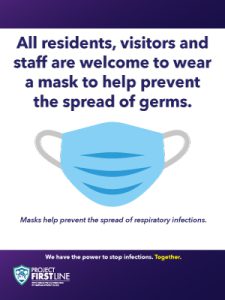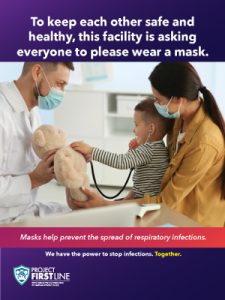Reminder: Infection Control Actions to Take During Respiratory Virus Season
Posted on byLast year’s considerable respiratory virus season saw spread of COVID-19, flu, and RSV, which led to extra stress on an already overwhelmed healthcare system. When respiratory viruses are spreading in the community, the risk for spread in healthcare settings increases as well. Remember: Regardless of your healthcare setting or which respiratory viruses are spreading in your community, these existing infection control measures can prevent and slow the spread to help protect patients and healthcare workers.
Check that the air handling in your facility is functioning as it should.
Make sure air vents aren’t blocked and consult with facilities management to ensure the heating, ventilation, and air conditioning, or HVAC, system is working efficiently for proper ventilation. Learn more by checking out Ventilation in Healthcare Settings.
Guidance on ensuring that ventilation systems are operating properly, and other options for improving indoor air quality, are available in the following resources:
- Guidelines for Environmental Infection Control in Health-Care Facilities
- American Society of Heating, Refrigerating and Air-Conditioning Engineers (ASHRAE) resources for healthcare facilities
- Ventilation in Buildings, which includes options for non-clinical spaces in healthcare facilities
Consider broad source control in healthcare facilities during respiratory virus season.
Source control is an important tool to keep germs from spreading. It stops germs at their source, before they can spread to other people. Well-fitting facemasks or respirators covering a person’s mouth and nose can prevent spread of respiratory secretions when people are breathing, talking, sneezing, or coughing. CDC recommends that source control be used by people with symptoms of a respiratory infection and those who were recently exposed to someone with a respiratory infection. The overall benefit of broader masking is likely to be the greatest for patients at higher risk for severe outcomes from respiratory virus infection and during periods of high respiratory virus transmission in the community. Facilities could consider expanding mask use to these situations; operationalizing broader masks use in a facility could include recommending healthcare workers use masks for certain types of patients or during the typical respiratory virus season.
Use data for local decisions.
In addition to local measures that facilities have access to, CDC provides measures at a national or state level that can help inform decisions about broader mask use. Facilities can consider levels of infection along with rate of increase. Data include:
- The RESP-NET interactive dashboard or data from the National Emergency Department Visits for COVID-19, Influenza, and Respiratory Syncytial Virus
- Outpatient respiratory illness visits determined by data reported to ILINet, which are aggregated to provide state-level estimates
- Local health department data on respiratory virus activity for your jurisdiction
- Visits or admissions for respiratory symptoms within your facility
- Hospital admissions data on the CDC COVID data tracker
- Long-term care data from the National Healthcare Safety Network LTCF COVID-19 Module, CDC COVID Data Tracker: Nursing Home Residents, and CMS COVID-19 Nursing Home Data
If your facility decides to institute masking, Project Firstline has created signs to help encourage masking that you can download, share, and print. You can add your facility’s logo to customize them if you wish.
Encourage all who are eligible to get vaccinated.
Vaccination of healthcare workers is an important infection control measure that can reduce the spread of respiratory viruses and staff absenteeism. Recommended vaccines are safe and effective and protect not only healthcare workers, but also the patients and residents in their care.
For more information on vaccine recommendations visit:
- ACIP Seasonal Influenza Vaccine Recommendations
- ACIP COVID-19 Vaccine Recommendations
- ACIP RSV Vaccine Recommendations
Encourage physical distancing and implement screening and triage procedures.
To limit the spread of respiratory viruses, encourage physical distancing in healthcare settings – particularly in shared spaces like waiting rooms. Consider:
- posting signs reminding people to notify facility staff at check in if they have respiratory symptoms
- setting up triage stations that facilitate rapid screening of people for respiratory symptoms during times of higher community respiratory virus transmission
- placing patients with signs or symptoms of a respiratory infection on empiric respiratory precautions, including separating them from others as soon as possible and asking them to wear a mask, while they undergo evaluation
Also take advantage of telemedicine and use telehealth appointments for patient care when appropriate. These strategies significantly decrease the risk of spreading illness.
Help everyone practice respiratory hygiene and cough etiquette.
Ensure all staff, patients, and residents can practice respiratory hygiene and cough etiquette. Provide masks, tissues, and no-touch receptacles for tissue disposal at facility entrances, triage areas, and waiting rooms.
Promote hand hygiene with everyone in the facility.
Remind everyone to clean their hands regularly with alcohol-based hand sanitizer or soap and water. Make sure there is consistent access to hand sanitizer dispensers and supplies for handwashing across the facility. Use CDC’s Clean Hands Count resources to share key messages and reminders within your facility.
Practice regular environmental cleaning.
Lobby areas, cafeterias, and waiting rooms are all high-traffic spaces where respiratory viruses can spread. These areas should be cleaned regularly. It’s also important to disinfect reusable devices and not reuse disposable items. Check out this resource on How to Read a Disinfectant Label to help ensure you are using products correctly.
Additional Resources
For weekly updates from CDC, visit CDC Respiratory Virus Updates.
For more information on COVID-19 infection control recommendations for healthcare settings, visit the Interim Infection Prevention and Control Recommendations for Healthcare Personnel During the Coronavirus Disease 2019 (COVID-19) Pandemic.
For more information on seasonal influenza, visit Prevention Strategies for Seasonal Influenza in Healthcare Settings.
For additional infection control education and training resources, visit Project Firstline.
About the Authors
Posted on by



